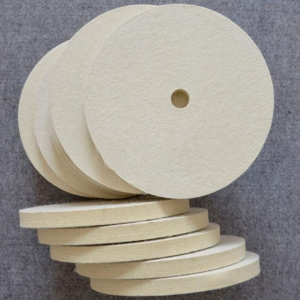The wool felt wheel market is in a constant state of flux, driven by technological advancements, changing consumer preferences, and evolving industry demands. As we look towards the future, several emerging trends are shaping the landscape of this market, presenting both opportunities and challenges for manufacturers, suppliers, and users alike.
One of the most significant trends is the increasing demand for high – precision wool felt wheels. With industries such as electronics, micro – machining, and semiconductor manufacturing becoming more advanced, the need for ultra – fine polishing and finishing has grown exponentially. Manufacturers are responding by developing wool felt wheels with finer textures and more precise manufacturing processes. These high – precision wheels can achieve a surface finish with extremely low roughness values, making them suitable for applications where even the tiniest imperfection can affect the performance of the final product. For example, in the production of microchips, high – precision wool felt wheels are used to polish the delicate surfaces of semiconductor wafers, ensuring the proper functioning of the chips.
Another trend is the growing popularity of wool felt wheels with integrated smart features. The Internet of Things (IoT) and Industry 4.0 are revolutionizing the manufacturing industry, and wool felt wheels are not left behind. Some manufacturers are now incorporating sensors into wool felt wheels to monitor parameters such as temperature, pressure, and wear. This data can be transmitted in real – time to a central system, allowing users to optimize the polishing process, predict maintenance needs, and improve overall efficiency. For instance, a sensor – equipped wool felt wheel can alert the user when it is approaching the end of its lifespan, preventing unexpected tool failures and reducing downtime.
Sustainability remains a key trend in the wool felt wheel market, but it is evolving in new ways. In addition to using natural wool and adopting eco – friendly manufacturing processes, there is a growing focus on the circular economy. Manufacturers are exploring ways to recycle and reuse wool felt wheels, reducing waste and conserving resources. Some companies are developing systems for collecting used wool felt wheels, cleaning and refurbishing them, and putting them back into circulation. This not only benefits the environment but also provides cost – savings for users who can purchase refurbished wheels at a lower price.
The rise of e – commerce is also having a profound impact on the wool felt wheel market. With more consumers turning to online platforms to purchase tools and equipment, manufacturers and suppliers are investing in digital marketing and online sales channels. This has led to increased competition as companies strive to stand out in the crowded online marketplace. To succeed, businesses are focusing on providing excellent customer service, detailed product information, and fast shipping options. At the same time, e – commerce has also opened up new opportunities for smaller manufacturers and niche players to reach a global audience.
As the wool felt wheel market continues to evolve, staying ahead of these emerging trends will be crucial for all stakeholders. Whether it’s developing high – precision products, embracing smart technology, promoting sustainability, or leveraging e – commerce, companies that can adapt to these trends will be well – positioned for success in the dynamic and competitive world of wool felt wheels.

Post time: Jun-06-2025
